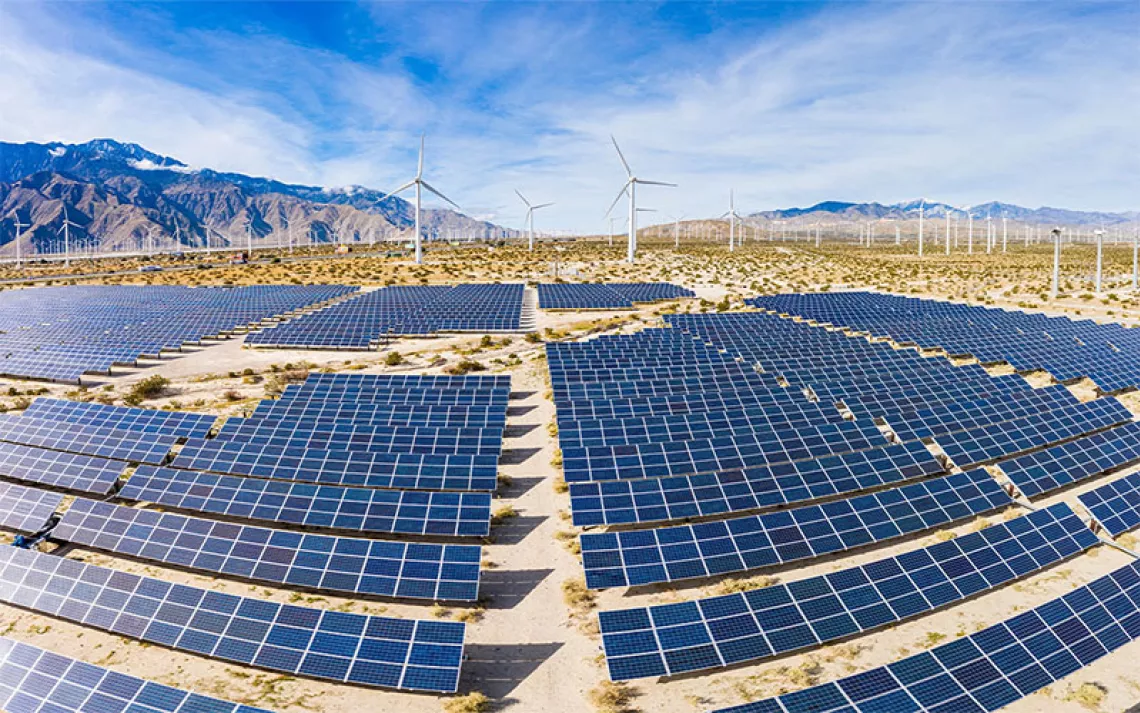Could South Miami’s New Solar Measure Be Adopted Nationwide?
One tireless teen advocate thinks so

Photo by csfotoimages/iStock
In the midst of devastating hurricanes, flooding, and sea-level rise, Florida teenager Delaney Reynolds has some choice words for President Trump: “You talk a lot about job creation,” she says. “I would like to see you make sustainable jobs a priority—both to put people to work and to help transition those in fossil fuels or utility jobs into clean-industry jobs.”
Reynolds is the founder of the Sink or Swim Project—a tool to engage young Floridians in political action around climate change. The college freshman splits her time between the University of Miami and her native No Name Key, a 1,000-acre island in the Florida Keys, and has seen firsthand the past decade’s surge in flooding as well as other effects of sea-level rise. It’s why she spent much of her adolescence advocating for climate action and working with the mayor of South Miami to pass a revolutionary measure that will go into effect on September 18—a law mandating that anyone building a new home or renovating more than 75 percent of an old one must install solar panels. The Miami Herald reports, “Under the rules, new residential construction would require 175 square feet of solar panels to be installed per 1,000 square feet of sunlit roof area, or 2.75 kw per 1,000 square feet of living space, whichever is less. If the house is built under existing trees, the shade may exempt it.”
Reynolds, who believes the United States could become the world’s largest manufacturer of solar power panels and equipment, doesn’t plan to stop there. “There’s no reason the entire state, much less our country, can’t adopt mandatory solar laws and transition from a fossil fuel economy to a sustainable one.”

Reynolds isn’t alone in this. Retired director of the National Oceanic and Atmospheric Administration (NOAA) Earth System Research Laboratory Alexander MacDonald, for instance, has advocated for a new national transmission system that would allow states to share energy, noting that this would put the country in a position to switch to a combination of solar and wind power (sun wouldn’t provide sufficient power in some locations). MacDonald and his colleagues published a 2016 study that looked at future cost-comparative electricity systems and their impacts on carbon dioxide emissions, and found that CO2 reductions “are possible with current technologies and without electrical storage.” The study goes on to state, “Wind and solar power increase their share of electricity production as the system grows to encompass large-scale weather patterns. This reduction in carbon emissions is achieved by moving away from a regionally divided electricity sector to a national system enabled by high-voltage direct-current transmission.”
Joshua D. Rhodes, PhD, a fellow at the University of Texas at Austin Energy Institute, estimates in Business Insider that the cost of replacing the current U.S. electrical grid would be $5 trillion. On the question of converting the system to sustainable energy, Rhodes writes, “One area that does look promising for infrastructure investment is upgrading the bulk power transmission network. These upgrades could allow power to flow between regions of the U.S. . . . similar to the interstate highway system.”

Sign up to receive Sierra News & Views
Get articles like this one sent directly to your inbox weekly.
With this action you affirm you want to receive Sierra Club communications and may vote on policy designated by the Sierra Club Board.
Reynolds envisions Florida as the cornerstone of such a system. “My dream is to see the Sunshine State become known as the Solar State.” It’s why she’s been talking to citizens and policymakers of St. Petersburg, Orlando, and Sarasota about implementing solar measures similar to South Miami’s—and why she says she’d be “thrilled” to talk to people of any other city seeking to do the same.
Before working with the mayor to pass South Miami’s solar ordinance, Reynolds in 2015 mobilized Miami-Dade County to appoint its first-ever chief sustainability officer. Last June, Reynolds addressed the General Assembly of the United Nations and UNESCO on World Oceans Day, touching on how sea rise is affecting Everglades National Park. (She was accompanied by her 15–year-old brother Owen, who recently started his own organization called The Apollo Project, through which he’s building a solar-powered racecar.)
In the past year, Delaney Reynolds has participated in climate-related video shoots with MTV and Al Gore (she appears in An Inconvenient Special, answering questions about sea rise and climate change). She’s currently finishing a draft of her fifth book, a work of young adult nonfiction filled with what she says is “science anyone can understand, as well as stories of real people who are currently being impacted” by climate change. (Reynolds’s first four books, available through her website, are picture books she authored and illustrated; she self-published her debut at age 10.)
At the end of August, Reynolds started college as a marine science and biology major; she’s excited that the University of Miami’s president has named combatting sea-level rise as one of the school’s top six priorities. How exactly does Reynolds balance academics with her work for The Sink or Swim Project, her writing, and her speaking engagements? “I do have to make sacrifices such as skipping beach days or movies with friends,” she says, “but that’s never bothered me, because I know that the work I have been doing for our environment is so important.”
Topping her list of priorities is getting other communities to take a cue from South Miami and pass their own solar ordinances. As such, Reynolds is currently planning a follow-up to her first TedxTalk, in which she explained the Sink of Swim Project, so as to virtually coach communities around the world on how to follow suit.
 The Magazine of The Sierra Club
The Magazine of The Sierra Club



